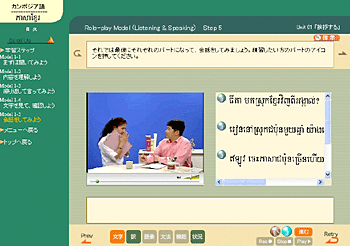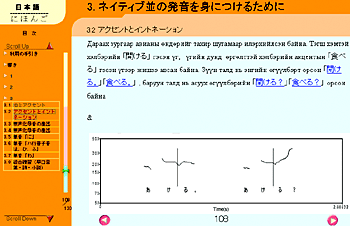Tokyo University
Article from the July edition of eTRANS
―TUFS Language Module Changes 21st
Century Foreign Language Education―

On April 9, Tokyo University
of Foreign Studies in Fuchu city held a conference announcing the success of
the 21st Century COE (
What is Linguistic Informatics?
Started
in 2002, the “Usage-Based Linguistic Informatics” is a research program of
Tokyo University of Foreign Studies, which was adopted by the 21st
Century COE Program of the Ministry of Education, Culture, Sports, Science and
Technology. Linguistic Informatics is the name of a new academic field that
combines linguistics and language education based on information technology.
Through the appearance of linguistic informatics, foreign language studies have
undergone the following changes.
1.
Foreign Language Studies by Purpose
Foreign language students have many needs, such as: “I just want to learn
pronunciation as fast as possible.” “I hate grammar, but would be motivated to
learn conversation.” “I want to base my foreign language study on vocabulary.”
We intend to respond to these various needs.
2.
Making Multilingualism a Reality
A foreign language is an important doorway to another culture. Finding and
widening that doorway at an early stage is critical for foreign language
studies in
3.
Improving the Effectiveness of Education Using Web Technology
With the use of multimedia, a more effective level of education can be
expected.
4.
Ubiquitous Education Environment (e-Learning)
The spread of the Internet has made possible an educational environment where
one can freely connect to the Internet from a computer anytime, anywhere.
In order
to achieve these goals, TUFS Language Modules were conceived; named after Tokyo
University of Foreign Studies.
TUFS Language Modules
|
|
|
[Online
Educational Materials in 17 Languages] |
http://www.coelang.tufs.ac.jp/modules/index.html
Seventeen
languages are targeted at the present time. Language materials were mainly
geared towards university students who are studying a foreign language other
than English for the first time. The English materials were designed keeping in
mind integrated study in elementary schools, or junior high schools where
English is studied for the first time as a foreign language.
Foreign
Language Studies by Purpose
TUFS
Language Modules are broken up into four modules: Pronunciation, Grammar,
Conversation, and Vocabulary. In the past, all of these aspects were treated as
one in most educational materials, but according to modular thinking, “Language
is four independent parts working closely together to make up the whole.” This
is the fundamental principle of TUFS Language Modules.
For
example, suppose that a businessman is being dispatched to Ho Chi Minh City,
As
was mentioned in “Foreign Languages Studies by Purpose” above, this modular
concept will respond to the various needs and educational styles for studying a
foreign language.
Similarly,
one can study daily conversation without being troubled with grammar by using
only the conversation module. If one wants grammatical explanation within the
conversation module, the answer can be found within the grammar module by
following the links placed within each module. Also, basic vocabulary may be
learned all at once using the vocabulary module.
Currently,
only the modules for pronunciation (12 languages) and conversation (17 languages)
are accessible, but the grammar and vocabulary modules are schedule to be added
within two years, completing the four modules. Originally, it was envisioned
that the modules would be used in university classes in various ways, but have
been made accessible on the network to everyone, free of charge.
A Cross-Linguistic Viewpoint
Another
major characteristics of these materials is that each of the modules for the 17
languages were made within a loose “common framework.” Of course, while being
designed with a common framework, the individuality of each language should not
be overlooked.
For
example, in the conversation module, expressions which fulfill the various
functions (roles) of language used in daily communication have been classified
into 40 language functions, from “1. Greeting someone,” “2. Thanking,” through
“40. Introducing someone.” These are put into patterns within situations where
they are actually used in conversation.
Lao Conversation Module (For Lesson Use)

The common framework for the 40 language
functions was adopted based on European and American syllabus research.
The
conversations include video, and may be played as a whole on the browser, or
listened to part by part. You may also choose whether you want the sentences or
translations displayed or not. It is also structured to allow very practical
uses such as repetition and role-play. In addition to the Lesson Use page shown
above, there is another Student Use page based on four practice models within
the conversation module.
Cambodian Conversation Module (For Student
Use)

It’s
easy to use. Choose a learning model from among 40 functions. After that,
follow the directions on the screen, and just click “Continue” on the bottom
right. You can repeat the lesson as many times as you like.
The
third module, grammar, is scheduled to be completed in fiscal 2004, and has
also been designed under a common framework. Grammar may be studied for not
just one language, but also a cross-examination of grammar for multiple
languages may be done. This perspective of cross-examining languages is called
“cross-linguistics,” and its integration into the development of grammar
educational materials is a concept unique to this project.
Ubiquitous Multilanguage Study
Another
distinguishing aspect of TUFS Language Modules is that they deal with multiple
languages. These modules provide the world’s first online educational materials
for Mongolian, Lao, and Cambodian. By using TUFS Language Modules, it will be
possible to learn about many foreign languages starting in junior and senior
high schools, even languages where there is no study environment in the
country. It will also be possible to expand development to other languages
aside from the currently available 17 languages. At Tokyo University of Foreign
Studies, the use of e-Learning will begin this year on a trial basis, and usage
will be centrally managed. There are also plans to begin research of a
descriptive model for language proficiency using TUFS Language Modules. This
research is innovative in that it attempts to measure language proficiency in multiple
languages with the same criteria and incorporates Asian languages.
21st Century Foreign Language University
The
21st Century COE is a project which will lead to the future plans of
every university. Up until now, Tokyo University of Foreign Studies has been
thought of as a university for Japanese people to study foreign languages. This
project attempts to change this conception. Not only will Japanese people be
able to learn foreign languages, but also Japanese and other languages will be
able to be learned through other languages, as module interaction becomes a
reality. The project has already started allowing Japanese pronunciation and
conversation to be studied in English, Chinese (traditional) and Mongolian.
TUFS Language Module (Multilingual Version)

http://www.coelang.tufs.ac.jp/english/modules/
This is a page for native speakers of
Mongolian to learn Japanese pronunciation.
Through the interactivity of
the TUFS Language Modules, foreign language universities like this one will
have the possibility of “achieving transformation into universities for
Japanese and other people to learn foreign languages or Japanese.” The day when this occurs is perhaps not
so far off. We hope to be seeing the results of this research.
Copyright
© 2004 Babel K.K. All Rights Reserved.
Babel K. K. www.babel.co.jp/
This page appeared in the July, 2004
edition of the translation information magazine eTRANS, pp. 58-59. It is
reprinted here by permission of Babel K. K.
